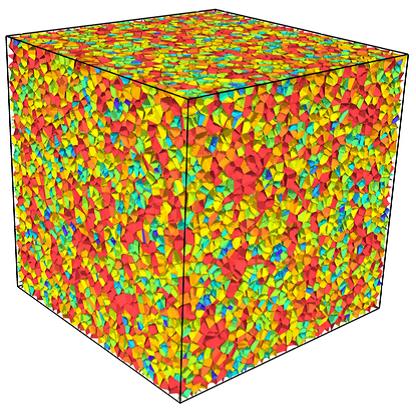Open PhD position: Simulation of Wave Propagation in Highly Heterogeneous Media
PHD THESIS CEMEF 2021: Simulation of Wave Propagation in Highly
Heterogeneous Media.
Context and goals
Elastic wave propagation is involved in many fields of science and engineering. In metallurgy for instance, one of the most important techniques for Non-Destructive Testing (NDT) consists in measuring the transmission and reflection of wave trains in an industrial part, in order to determine the position and the size of potential defects. Nowadays, this methodology is also more and more investigated to industrially detect abnormal grain size [1]. Most analytical and numerical models that describe the evolution of elastic waves at macroscale assume an homogeneous propagation medium, which is often the result of an approximation. The interaction between small-scale heterogeneous features and the waves may trigger diffraction and scattering effects, depending on their geometrical characteristics and on the wavelength. In many cases, the homogeneity assumption results in models of limited accuracy, and with restrictive conditions of validity.
The numerical methods and the computing resources that are available nowadays make it possible to consider direct numerical simulations of elastic wave propagation in highly heterogeneous media. Such simulations are particularly interesting in a multi-scale framework: the results of direct simulations in a Representative Volume Element (RVE) of a material then determines the parameters of an homogenized (or “mean-field”) model to be used at macro-scale. The main challenges in this problem are its geometrical complexity and the related computational cost: resolving all geometrical features implies a very fine discretization.The polycrystalline structure of metallic parts tested with ultrasonic methods is a good example of this class of problems. It forms a geometrically complex medium composed of grains whose mechanical properties are different. A typical RVE of a metallic microstructure can include hundreds to thousands of grains (see figure). In order to take into account the non-homogeneous nature of the material in NDT simulations at the scale of an industrial part, semi-analytical models are usually used. They rely on a very simplified statistical description of the microstructure and its interaction with the waves. New attempts at performing direct simulations on RVE’s have been recently reported in the literature [2,3].
The MSR team at CEMEF, in context of DIGIMU consortium, is developing an innovative numerical platform for the simulation of massively multi-domain problems in mechanics and materials science. It consists mainly in computational tools for the description of geometrically complex media, meshing methods, Finite Element solvers, front-tracking and front-capturing approaches, integrated in a High-Performance Computing (HPC) framework [4]. In this context, the team is willing to extend the platform with the capability to simulate elastic wave propagation in highly heterogeneous media, with a particular (albeit non-exclusive) interest in ultrasonic wave propagation in polycristalline microstructures.
The objective of the project is thus to develop a high-order FE method [5,6] for the equations of elastodynamics, that integrates in the software environment developed at DIGIMU consortium for the numerical simulation of polycrystalline microstructures. A particular attention will be paid to the efficiency of the parallel implementation on distributed memory architectures (MPI or hybrid OpenMP/MPI techniques). The method will be verified on academic test cases and applied primarily to ultrasonic wave propagation cases in metallic microstructures. Experimental data will be provided by the Aubert&Duval company.

References :
[1]D. Faucon. Etude de la corrélation entre microstructure et ultrasons dans les métaux: application au contrôle non destructif de l’alliage de TA6V. PhD thesis, Université de Montpellier, 2021.
[2]A. Van Pamel et al., Finite-element modelling of elastic wave
propagation and scattering within heterogeneous media. Proceedings of the Royal Society A: Mathematical, Physical and Engineering Science, 473, 2017.
[3] X. Bai et al., Finite element modeling of grain size effects on the ultrasonic microstructural noise backscattering in polycrystalline materials. Ultrasonics, 87, 2018.
[4] M. Bernacki et al., Recrystallization: Types, Techniques and Applications, Numerical Modeling of Recrystallization in a Level Set Finite Element Framework for Application to Industrial Processes. Nova Science Publishers, Inc., first edition, 2019.
[5] M. Bernacki et al., Parallel discontinuous galerkin unstructured mesh solvers for the calculation of three dimensional wave propagation problems. Applied mathematical modelling, 30, 2006.
[6] T. Toulorge. Efficient Runge-Kutta Discontinuous Galerkin Methods Applied to Aeroacoutics. PhD thesis, KU Leuven, 2012
Candidate profile and skills
Degree: MSc or MTech in Applied Mathematics, with excellent academic record.
Skills: Numerical Modeling, programming, proficiency in English, ability to work within a multi-disciplinary team.
General informations
- Doctoral speciality: Computational Mathematics, High Performance Computing and Data
- Location:The 3-year PhD, funded by MINES ParisTech, will take place in CEMEF, one of its internationally-recognized research laboratory located in Sophia-Antipolis, on the French Riviera.
- Keywords: Wave propagation, polycrystals, non-destructive testing, FE methods
- Gross annual salary: about 26k€
- Deadline to apply: 2021-08-30
Contacts
- Team: Metallurgy, µStructure, Rheology [MSR]
- Supervisor: Prof. M. Bernacki.
Moreover, Dr. T. Toulorge, specialist of FE-DG method [6] from cenaero company, and all the partners of the DIGIMU consortium will participate to this project for the academic and industrial planned developments.
To apply
- papers requiered to apply:
- your most recent CV
- Detailed, official proof of your grades during your most recent studies(maximum 3)
- One or more references from professors or heads of training programmes

